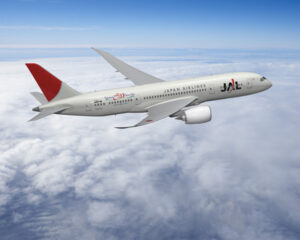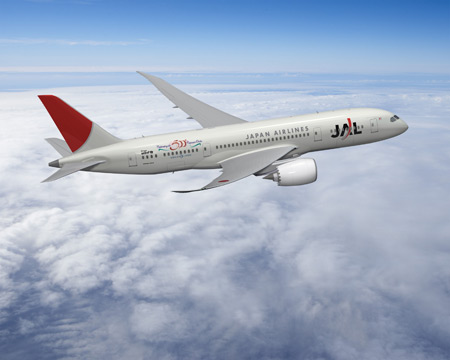In September 2011, Boeing handed over the first keys of a 787 Dreamliner to Japan’s All Nippon Airways (ANA).
This year, the other Japanese heavyweight, Japan Airlines, will be taking delivery of the aircraft in a fleet renewal and route restructuring effort.
The 787 is a twin-aisle airplane that can accommodate between 210 and 250 passengers on distances up to 8,200 miles (15,200 km) – making it the only mid-size airplane capable of very long-range routes.

The Dreamliner’s interior provides passengers a more spacious experience than on other twin-aisle planes, because of a ‘vaulted’ 8-foot ceiling and reshaped overhead luggage bins that drop down, while larger windows with electronic shadesprovide significantly more natural day light. Passenger comfort is further improved by maintaining air pressure at the equivalent of an altitude of 6,000 feet (1,800 meters) in comparison to 8,000 feet on previous aircraft, and higher levels of humidity.
787 deliveries
While the 787 is known to burn 20 percent less fuel than jetliners of a similar size, production of the plane has proven to be a challenge over recent years – mainly due to the fact that it’s the first large passenger jet to have more than half its structure made of lightweight composite material instead of aluminum. The ‘All Things 787’ blog reports that up until now, the pipeline of 787 production has been flowing into a quagmire, as Boeing has parked about 40 Dreamliners that require extensive rework at its Paine Field base. It’s only from March 2012 that the first 787s will be delivered straight from the production line without any need for rework. Boeing’ own forecasts expect to deliver between 35 and 42 787s in 2012, though analysts have projected a figure of up to 55 aircraft as a possibility.
Of the 55 787s it has on order, ANA has thus far received its first five aircraft. Other airlines that are likely to receive their first Dreamliner in 2012 include Air India (spring 2012), Qatar Airways, China Southern, Ethiopian Airlines (all mid-2012), Hainan Airlines (fall 2012) and LOT (end of 2012), as well as reportedly LAN, Royal Air Maroc and United Airlines. After launch customer ANA, the next operator of the 787 will be Japan Airlines (JAL), who will receive its first aircraft in February 2012.
JAL 787 passenger experience
The passenger experience on board the 787 has been a huge selling point for the plane, and many airlines have announced their intent to introduce onboard features and configurations. ANA’s 787s feature the airline’s ‘Inspiration of Japan’ experience, which was launched in early 2011. Similar to ANA’s low-density 158-seat configuration on international flights, JAL has opted for their 787s to hold 186-seats, which will include 42 business class seats in a 2-2-2 configuration and 144 economy class seats in a 2-4-2 configuration. In their 787 Executive Class cabin, JAL will use its angled lie-flat SHELL FLAT NEO seats, which are currently used on 777-300ER routes to New York, Los Angeles, Chicago and Jakarta.
In-flight entertainment on board the 787s will be JAL’s MAGIC-V system, which is the latest iteration of the airline’s MAGIC IFE system. Aside from the movies, music and other standard IFE features, JAL is also introducing SKY MANGA as a new feature on its 787s. It will be the world’s first in-flight electronic manga (Japanese comics) browsing service and from March, manga fans will be able to choose from up to 30 different titles on seatback video screens. JAL mentioned that the new offering would “respond to customer demand for diverse in-flight entertainment while also showing the world the Japanese art form we call manga.”
JAL 787 routes
JAL plans to commence flights between Tokyo Narita and Boston on April 22th, 2012 with its brand new plane. This will create the first direct connection between Boston and Asia and is JAL’s only new destination with its 787s. However, the airline is deploying 787s on five existing routes – namely to Moscow Domodedovo, New Delhi, Singapore and Beijing. According to CAPA, the 787’s size, capacity and cost efficiencies play well into JAL’s strategy for Moscow and Delhi, where the new plane will signal a strategic capacity reduction of 19 to 24 percent from the current 777-200ERs in service. In the case of Singapore and Beijing, the 787 will allow for transitioning away from JAL’s aging 767s, as well as addition of capacity from Haneda Airport. BusinessWeek reports that “flights to Singapore from Tokyo’s Haneda and the Narita airport will switch to the Dreamliner from 767s starting in September.

